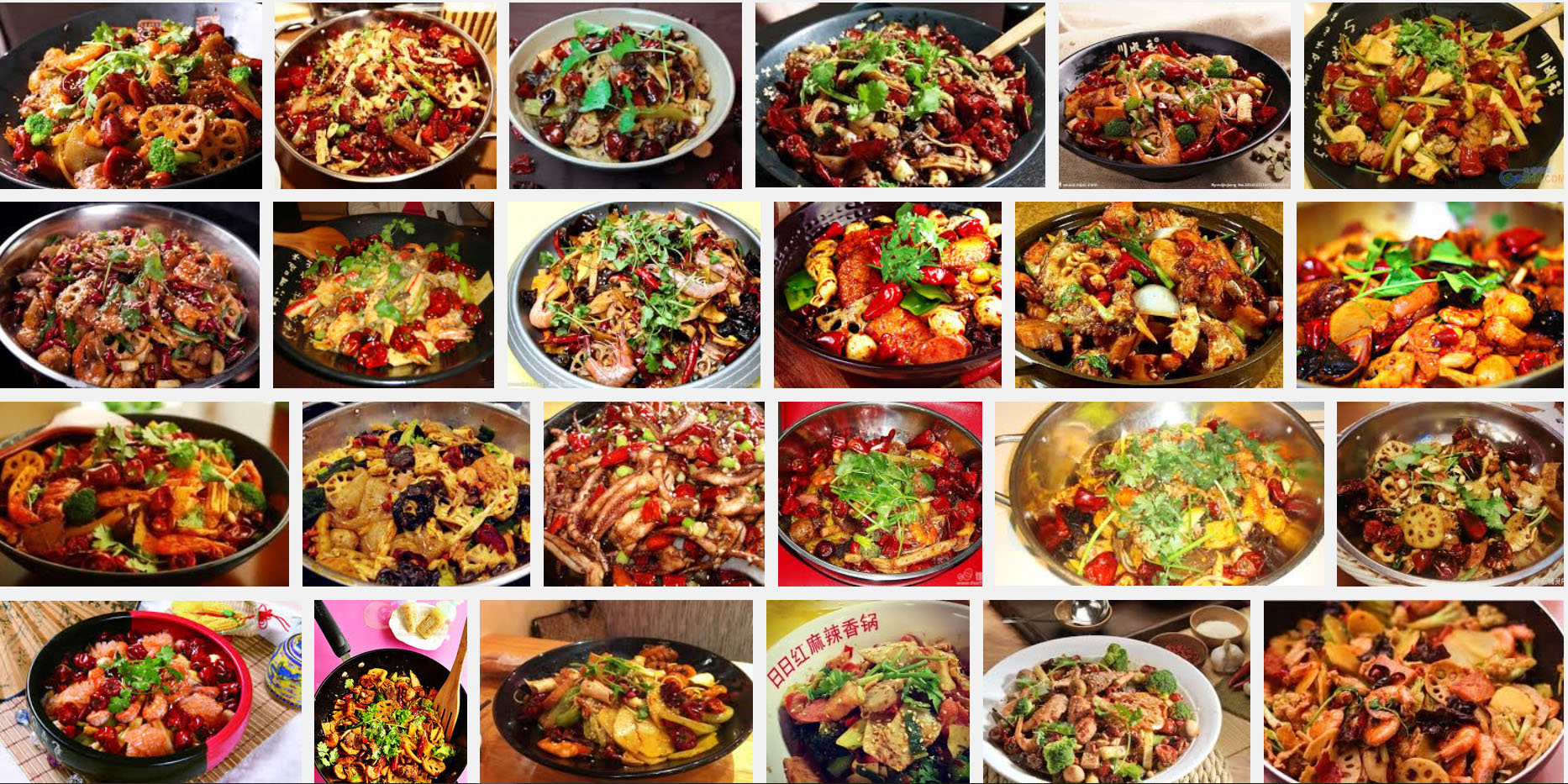
Sichuan cuisine became trendy during the Song Dynasty (1127-1279) in Hangzhou. In these later days, the food of Sichuan province is one of the ‘Four Major Cuisines’ in China, as well as one of the ’Eight Regional Cuisines’ of Chinese culinary tradition. Chengdu has been chosen by UNESCO as a ‘City of Gastronomy’ because of its illustrious culinary heritage.
The dishes from Chengdu, Zigong in the south of Sichuan, and from Chongqing define the Sichuan cooking style which is famous for its spices: the well known Sichuan pepper creates a tingly numbness in the mouth, despite it is not as hot as chili pepper and has a citrus aroma. Star anise comes from an evergreen tree in southwest China. The widely-used chili pepper came to Sichuan from Latin America through the spice trade in the 18th century, and the fennel seeds came from the Mediterranean.
Originally a creation of the Tujia Minority, Ma La Xiang Guo is one of the most popular home dishes in the Chongqing area. It is not only famous for its many combined flavours (numbing, spicy, salty, sweet and fragrant), but also for its varied choice of ingredients: chicken, pork, fish, potatoes, lotus root, mushrooms, tofu, cabbage, you name it! In fact, you can pretty much cook this dish with whatever is in your fridge.
As it is a home-cooked dish, people have the flexibility to adjust its spiciness and ‘numbing-ness’. It can be a meat dish, a vegetarian dish and even a vegan dish. In addition, sometimes families and restaurants add different herbs and spices according to Traditional Chinese Medicine. Carefully selected, these extra herbs are added for their health benefits and are varied based on the season.
Let’s see how to cook this dish with pork.
Note:
- with this recipe, if you do not eat pork, you can use beef, chicken or seafood instead. For the vegetarian and vegan version, simply cook the dish without animal products, or substitute the pork with extra mushrooms, other vegetables, or tofu.
- if you could not find the Sichuan chilli bean paste, you could use some other local spicy sauces instead of it.
Serve 4
Ingredients:
200g pork belly
100g lotus root
100g lettuce stem
1 small block of the smoked tofu
200g broccoli
100g bamboo shoots
100g celery
200g assorted mushrooms
50g leek
10 cloves of garlic
15g ginger
1-2 stalks of coriander
3 tbsp of Sichuan Pixian chilli bean paste *
1 tbsp of oyster sauce*
2 tbsp of light soy sauce *
2 tsp of sugar or sugar for taste*
1 tsp of salt or salt for taste*
100ml vegetable oil *
1-2 tsp of sesame oil *
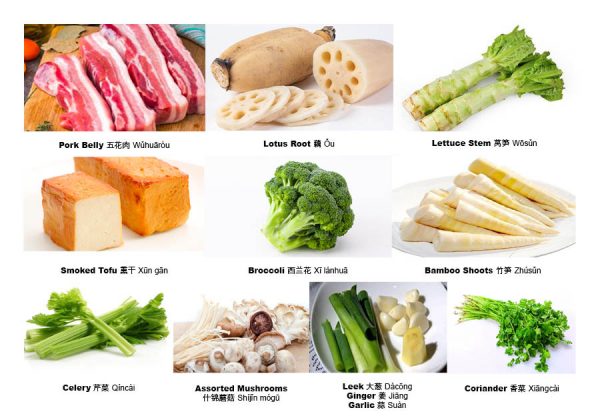
Spices:
1 tbsp of Sichuan peppercorn, or according to taste
80g of dried chili peppers, or according to taste 1 tsp of fennel seeds
1 tsp of fennel seeds
3 pieces of star anise
2 bay leaves
1 piece of cinnamon 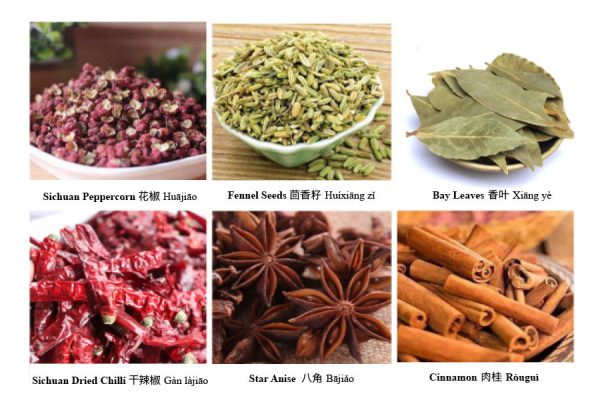 Method:
Method:
Thinly slice the pork belly; cut all the vegetables: lotus root, stem lettuce, bamboo shoots, celery, mushrooms and tofu into pieces, and cut broccoli into bite-size pieces. Cut garlic, ginger and leek into big pieces and roughly chop the coriander.
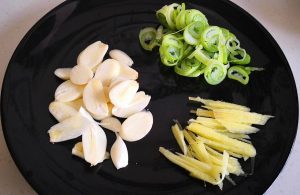
Bring a pot of water to a boil with salt. Blanch the lotus root, stem lettuce and broccoli for 2 minutes. Remove and dip into cold water, then drain for later use.
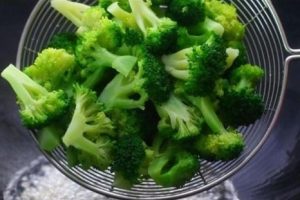
Heat 100ml oil in the wok and add bay leaves, star anise, fennel seeds, cinnamon bark, dried chili pepper, and Sichuan peppercorn. Stir-fry till fragrant. Add the Pixian Doubanjiang paste and the sliced pork. Stir-fry till the meat turns brown and releases fat. Add garlic and ginger and stir-fry till fragrant.

Add the mushrooms. Fry about 2 minutes till the mushroom juice is released and starts evaporating. Add the lotus root, stem lettuce, broccoli, celery, bamboo shoots and tofu. Stir-fry for another 2-3 minutes. Season with cooking wine, soy sauce, oyster sauce, sugar and salt according to taste and mix in the leeks.
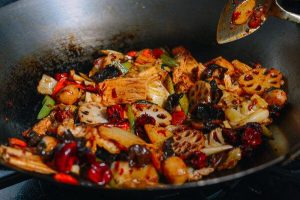
Top it off with some sesame oil and some fresh coriander on top. Enjoy with rice!
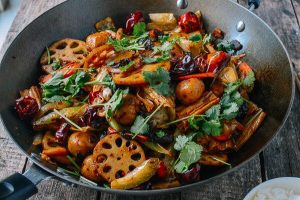
Note:
- Pixian chilli bean paste 郫县豆瓣酱 Pí xiàn dòubàn jiàng
- Oyster Sauce 蚝油 Háoyóu
- Light soy sauce 生抽 Shēng chōu
- Cooking wine 料酒 Liàojiǔ
- Vegetable oil 植物油 zhíwùyóu
- Sesame oil 香油 Xiāngyóu
- Salt 盐 Yán
- Sugar 糖 Táng
If you are interested in knowing more about this dish, please feel free to click here for a related article.
Pictures are from the internet 图片来自网络
中文菜谱点击这里
For more information, please contact us.
Email: info@thehutong.com Mobile & Wechat: 15901046127
We are looking forward to continuing to provide exceptional cultural experiences in a fun learning environment in 2020.













